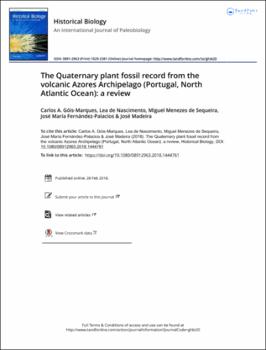The Quaternary plant fossil record from the volcanic Azores Archipelago (Portugal, North Atlantic Ocean): a review
Fecha
2018-02-28Resumen
Plant fossils are known from the Azores Islands, yet poorly studied. We present a comprehensive
bibliographical review for the archipelago. A first pre-scientific reference dates from late fifteenth century,
while the first scientific description was reported in 1821, accounting for trunks in pyroclastic units and
silicified plants within hydrothermal deposits. Throughout the second-half of the nineteenth century and
the first-half of the twentieth century, prospection by naturalists and geological mapping work, led to
the discovery and description of plant fossils in most islands. From the 1970s onwards, the taxonomic
interest ceased, and plant fossils were used mainly for 14C dating. Recently, sediment cores from lakes
and peatlands were used for palaeoecological reconstructions and to measure anthropogenic impacts.
Generally, plant fossils are younger than 50 ka, although older fossils may exist. Azorean plant fossils
include somatofossils of leaves, stems, logs and seeds preserved as impressions, compressions, adpressions,
permineralizations, lava tree casts and mummifications. The taphonomy of macrofloral elements is usually
related to explosive volcanic activity, while palynological record is associated with lake sediments and
peat bogs. The persistence in palaeobotanical and palaeopalynological studies will decisively contribute
to disentangle the paleodiversity, palaeoecology, and add crucial information on insular plant phylogeny
and biogeography






